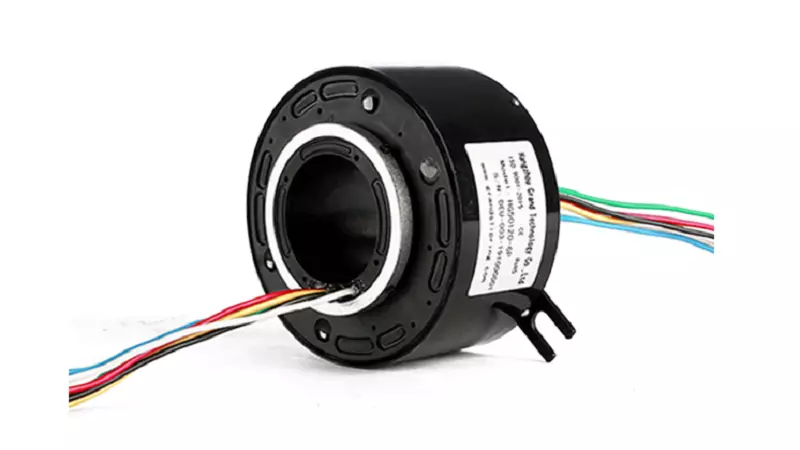Slip rings are crucial components in electrical projects that enable the transmission of signals and power between stationary and rotating parts. They play a significant role in various applications, including robotics, wind turbines, surveillance systems, and medical equipment. When it comes to slip rings, there are different options available, including DIY slip rings and through-hole slip rings. In this comparative analysis, we will explore the construction, benefits, applications, and performance of DIY slip rings and through-hole slip rings. By the end of this article, you will have a comprehensive understanding of these two types of slip rings, enabling you to make an informed decision for your electrical project.
DIY Slip Rings: Construction, Benefits, and Applications
DIY slip rings are slip rings that individuals or hobbyists construct themselves using readily available materials and components. The construction process involves assembling the necessary parts to create a mechanism that facilitates the transmission of electrical signals and power. DIY slip rings offer several benefits, including versatility, customization options, and cost-effectiveness. They allow individuals to tailor the design and functionality of the slip ring to their specific project requirements. DIY slip rings find applications in a wide range of projects, including robotics, motorized camera gimbals, rotating displays, and various DIY electronics. The flexibility and versatility they offer make them popular among hobbyists, makers, and tinkerers.
Through Hole Slip Rings: Design, Advantages, and Use Cases
Through hole slip rings, on the other hand, are commercially manufactured slip rings designed for professional and industrial applications. They are constructed using precision engineering techniques and high-quality materials to ensure reliable performance and durability. Through hole slip rings are characterized by their robust design, easy installation, and reliable electrical transmission. They are designed to be mounted through a hole in the rotating part, allowing for easy electrical connection. Through hole slip rings find applications in industries such as automation, packaging, wind energy, and medical equipment, where continuous rotation and high transmission capacity are critical. Their standardized design and reliable performance make them an ideal choice for demanding industrial and professional applications.
DIY Slip Ring Construction: Step-by-Step Guide
If you choose to build a DIY slip ring, following a step-by-step guide can help you successfully construct one. Here is a detailed guide to building a DIY slip ring:
- Gather the necessary materials: To construct a DIY slip ring, you will need a rotor, stator, brushes, connectors, and wires. These components can often be sourced from electronics stores or online suppliers.
- Prepare the rotor and stator: Ensure that the rotor and stator are clean and free from debris or contaminants.
- Install the brushes: Attach the brushes to the stator, ensuring they have proper contact with the rotor. The brushes provide the electrical connection between the stationary and rotating parts.
- Connect the wires: Wire the brushes to the external connectors, which will carry the electrical signals and power.
- Assemble the slip ring: Secure the rotor and stator together, ensuring proper alignment and smooth rotation. Use appropriate fasteners to hold the parts securely.
- Test the slip ring: Once the slip ring is assembled, perform thorough testing to ensure proper electrical transmission and functionality.
Through Hole Slip Ring Installation: Best Practices
Installing a through hole slip ring involves specific considerations to ensure optimal performance. Here are some best practices for through hole slip ring installation:
- Prepare the mounting location: Identify the appropriate mounting location on the rotating part. Ensure there is sufficient space and access for the slip ring to be installed.
- Drill a hole: Carefully drill a hole through the rotating part at the designated mounting location. The size of the hole should match the dimensions of the through hole slip ring.
- Install the slip ring: Insert the through hole slip ring into the hole, ensuring a secure fit. Ensure that the electrical connections align with the appropriate terminals or connectors.
- Secure the slip ring: Use fasteners or mounting brackets to secure the slip ring in place, ensuring it remains stable during operation.
- Connect the electrical wires: Connect the electrical wires from the slip ring to the appropriate terminals or connectors in the system.
Performance Comparison: DIY Slip Rings vs. Through Hole Slip Rings
When comparing the performance of DIY slip rings and through hole slip rings, various factors come into play. DIY slip rings offer customization options and cost-effectiveness, but their performance may vary depending on the construction quality and materials used. They may have limitations in terms of signal quality, electrical noise, and rotational speed. Through hole slip rings, on the other hand, are designed for high-performance applications. They are engineered to provide reliable electrical transmission with low electrical noise, high signal integrity, and smooth rotation. Through hole slip rings can handle higher power and operate at higher speeds compared to DIY slip rings.
Cost Comparison: DIY Slip Rings vs. Through Hole Slip Rings
Cost is an important consideration when choosing between DIY slip rings and through hole slip rings. DIY slip rings are often more affordable compared to commercially manufactured slip rings. The cost of DIY slip rings primarily includes the price of the components and materials used for construction. However, it’s important to consider the time and effort required for construction, as well as the potential need for troubleshooting or modifications. Through hole slip rings, being commercially produced, may have a higher upfront cost. However, they are typically designed for long-term reliability and performance, which can result in cost savings in terms of maintenance and potential downtime in the future.
Application Considerations: Choosing the Right Slip Ring
When choosing the right slip ring for your project, it is essential to consider the specific application requirements. Factors such as project complexity, performance expectations, customization needs, and budget constraints should be evaluated. DIY slip rings are well-suited for projects that require flexibility and customization. They find applications in various creative projects, robotics, motorized camera gimbals, and rotating displays. DIY slip rings allow for tailoring the slip ring design and functionality to specific project needs. Through hole slip rings, with their reliable performance and ease of installation, are ideal for industrial and professional applications. They are commonly used in machinery, automation systems, and other applications where continuous rotation and high transmission capacity are critical.
Case Studies: Successful Projects with DIY Slip Rings and Through Hole Slip Rings
To further illustrate the capabilities of DIY slip rings and through hole slip rings, let’s explore some case studies of successful projects utilizing these slip rings:
- DIY Slip Ring Case Study: Robotic Arm
– A hobbyist constructed a DIY slip ring to enable seamless electrical transmission in a robotic arm project. The slip ring allowed for continuous rotation of the arm while maintaining electrical connectivity between the stationary and rotating components. The DIY slip ring provided the necessary flexibility to customize the design and meet the specific requirements of the robotic arm project.
- Through Hole Slip Ring Case Study: Wind Turbine
– In a wind turbine application, a through hole slip ring was used to enable the transmission of electrical signals and power from the stationary base to the rotating blades. The slip ring allowed for continuous monitoring of turbine performance and efficient power generation. The through hole design facilitated easy installation and ensured reliable electrical transmission even in harsh weather conditions.
These case studies highlight the successful integration of DIY slip rings and through hole slip rings in different projects. DIY slip rings offer the advantage of customization and affordability for hobbyist and creative projects. Through hole slip rings, with their standardized design and reliable performance, are well-suited for industrial and professional applications where high transmission capacity and durability are crucial.
Conclusion
In conclusion, DIY slip rings and through hole slip rings are two distinct options for electrical projects, each with its own set of advantages and considerations. DIY slip rings offer flexibility, customization options, and cost-effectiveness, making them suitable for hobbyist and creative projects. Through hole slip rings, with their reliable performance, easy installation, and standardized design, are ideal for industrial and professional applications. When choosing between DIY slip rings and through hole slip rings, consider factors such as performance requirements, customization needs, budget constraints, and the level of technical expertise available.
By understanding the construction, benefits, applications, performance, and cost factors associated with DIY slip rings and through hole slip rings, you can make an informed decision that aligns with your project requirements. Whether you choose the creativity and cost-effectiveness of DIY slip rings or the reliability and performance of through hole slip rings, slip rings play a critical role in enabling seamless electrical transmission in a wide range of applications.

